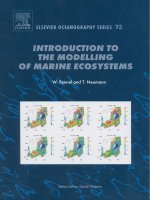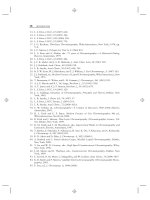Introduction to Environmental Science 12:008/159:008 Spring 2002 pptx
Bạn đang xem bản rút gọn của tài liệu. Xem và tải ngay bản đầy đủ của tài liệu tại đây (2.73 MB, 13 trang )
16. Water Pollution 1
Introduction to Environmental Science 12:008/159:008
Spring 2002
Water Pollution
Ohio
1950’s-1970’s
• Organic flammable compounds were
commonly disposed in rivers (sewer
systems).
• 1960’ common children pastime was to
set small fires on the water.
• 1968 Cuyahoga River, flowing
through Cleveland set on fire
destroying seven bridges
• Many areas of the Great Lakes
(rivers, channels, bays) heavily
polluted as the Cuyahoga.
LOVE CANAL (Niagara Falls, NY)
•Canal excavated in 1892
by W. T. Love for
commercial purposes.
Canal not completed.
•Served as a recreation
area after failure.
LOVE CANAL
(Niagara Falls, NY)
• 1930 - 1950’s Hooker Chemical (Occidental)
used ditch to dump chemical wastes in barrels
(over 80 different chemicals, 20,000 tons)
• 1953 Land sold to city for $1
• City develops area, builds schools and houses
around area, playgrounds over the site.
LOVE CANAL
•
•
Winter 1976
Winter 1976
-
-
77 Heavy rain/snow
77 Heavy rain/snow
–
–
vegetation dies, rubber disintegrates
vegetation dies, rubber disintegrates
–
–
dogs develop sores
dogs develop sores
–
–
appearance of puddles of toxic or
appearance of puddles of toxic or
noxious substance, basement flooded
noxious substance, basement flooded
–
–
claims of miscarriages, birth defects,
claims of miscarriages, birth defects,
blood and liver abnormalities
blood and liver abnormalities
–
–
Beverly
Beverly
Paigen
Paigen
does systematic study,
does systematic study,
and find link between
and find link between
“
“
wet
wet
”
”
homes and
homes and
the above
the above
16. Water Pollution 2
Introduction to Environmental Science 12:008/159:008
Spring 2002
LOVE CANAL
• 1978 State identified
numerous toxic and
noxious chemicals
– benzene, dioxin,
dichloroethylene,
chloroform
• 1978 State identified
numerous toxic and
noxious chemicals
– benzene, dioxin,
dichloroethylene,
chloroform
LOVE CANAL
• Families (600)
demand state to
relocate them (at
state expense).
LOVE CANAL
• State and Federal
government buy and
destroy over 200 homes.
• By 1990 $275 million spent
in cleanup
• Site lined with thick plastic and covered with impermeable
clays. Barriers to prevent groundwater movement built
around site.
• Contaminated soil and sediment removed and treated.
• Area considered clean. Homes back in the market.
• Area being monitored permanently.
LOVE CANAL - Remediation
• Life of container not known. Integrity of containers
holding chemicals was compromised
• Bureaucracy lost track of site history.
• Construction practices increased infiltration accelerated
problem.
LOVE CANAL - What went wrong?
Love Canal - Benefits
• Raised citizen awareness about hazardous waste
• Triggered or aided critical environmental legislation
(superfund sites - CERCLA: Comprehensive
Environmental Response, Compensation, and Liability
Act)
• Brought attention to the numerous potential problem
sites and need for sound and safe waste management
practices.
• You can now buy a house there for a really cheap
price ;)
16. Water Pollution 3
Introduction to Environmental Science 12:008/159:008
Spring 2002
Water Pollution
• Pollutant
– Any substance that does not belong in
the natural system and disrupts the
natural balance
• Water Pollution
– Degradation of water quality in a manner
that disrupts/prevents its intended or
original use.
• Surface Water
• Groundwater
HAZARDOUS
WASTE
1976 Resource Conservation and Recovery Act (RCRA)
• A waste/combination of wastes, which b/c of its concentration,
quantity, or physical, chemical, or infectious characteristics
may
1.
Cause or significantly contribute to an increase in
mortality or an increase in serious irreversible or
incapacitating reversible illness, or
2. Pose a substantial present or potential hazard to
human health or the environment when improperly
treated, stored, transported, or disposed of.
HAZARDOUS MATERIALS -
HAZMAT
• Listed waste
(recognized as hazardous by prior legislation/testing.)
• Characteristic waste that exhibits one or more of
the following:
– FLAMABLE
– EXPLOSIVE
– IRRITANT OR SENSITIZER
– ACIDIC OR CAUSTIC
– TOXIC
• Mixture of nonhazardous and hazardous waste
• Not specifically excluded from regulation
(i.e. if we don’t know we assume it to be hazardous).
TOXIC MATERIALS
• A material is said to be toxic if it is in one
of the following categories:
– Allergens and immune system depressants
– Neurotoxins
– Mutagens
– Teratogens
– Carcinogens
• Ricin, a protein found in castor beans, is
the most toxic substance known
Hazardous Substances
• Heavy Metals
(neurotoxins)
– Lead,
Mercury
Mercury,
Arsenic
Arsenic,
Cadmium, Tin,
Chromium, Zinc,
Copper
•
•
Arsenic
Arsenic
•
•
Skin numbness, thickening,
Skin numbness, thickening,
discoloration, cancer
discoloration, cancer
Hazardous Substances
• Non-biodegradable Synthetic and
Natural Organic Chemicals
– Most troublesome are Halogenated
Hydrocarbons. Contain: Chlorine, Fluorine,
Bromine, or Iodine. Chlorinated
hydrocarbons most common.
•Developmental problems due
to their ability to mimic
Hormones, or disrupt
metabolic pathways.
16. Water Pollution 4
Introduction to Environmental Science 12:008/159:008
Spring 2002
Water pollution contaminant types
• Infectious agents
• Oxygen-demanding Wastes
• Plant nutrients and cultural
eutrophication
• Toxic tides
• Inorganic Pollutants
– Metals, nonmetallic salts, acids and
bases
• Organic Chemicals
• Sediment
• Thermal Pollution and thermal shocks
MCL and secondary MCL
• MCL=Maximum Contaminant Level
– The highest concentration of a pollutant
allowed in drinking water by law
– Concentration above which adverse
health affects are believed to occur
• Secondary MCL
– Concentration of a pollutant above which
the water is unpleasant in odor or taste
– May not be hazardous to your health at
that level
Hormesis
Threshold
Linear
Pollution Sources
• Point-source
– Smokestack /
industrial effluent
– Oil Tanker spill
• Non point source
– Atmospheric
deposition
– Farm field runoff
Surface Water
• Sustains numerous ecosystems
that fulfill important roles in
biogeochemical cycles and the
water cycle.
• Source (major?) of food.
• Major source of drinking water.
• Recreational/aesthetic value
16. Water Pollution 5
Introduction to Environmental Science 12:008/159:008
Spring 2002
Surface Water
• Photosynthetic organisms (light is
essential).
–Phytoplankton - microscopic,
floaters.
• green algae, diatoms, cyanobacteria.
–Benthic Plants
• Submerged (plant fully under water)
– pond weed, muskgrass
• Emergent (plants partial above water)
– water lilies, cattails
Surface Water
• Non photosynthetic organism -
consumers. Includes floating,
swimmers, benthic.
– Zooplankton - microscopic, floaters
– Fish, Amphibians (froggies ), Reptiles
(Crocs, Turtles, Snakes)
– Mollusks (snails, clams), Crustaceans
(crayfish)
– Birds (ducks, geese, swans, etc.)
– Mammals (otters, raccoons,
muskrats …
)
Essentials
• Light - essential for primary
producers.
• Oxygen - essential for all
consumers.
• Nutrients - in balanced quantities
to maintain equilibrium between
populations.
Light
• Photic or Euphotic Zone
–Depth to which adequate light for
photosynthesis can penetrate.
–Controlled by amount of particulate
matter (sediment, plankton, and
organic debris) in the water column.
16. Water Pollution 6
Introduction to Environmental Science 12:008/159:008
Spring 2002
Oxygen
• Dissolved Oxygen – DO
– Amount of oxygen available in the water.
– Oxygen in water maintained by
• exchange with the atmosphere
• Production of oxygen by photosynthetic organisms
(vegetation)
• Circulation of water (essential to maintain oxygen
levels in deeper portions)
– Oxygen consumed by decaying organic
matter and oxygen breathing organism.
BOD
• Biochemical Oxygen Demand
–Measure of the amount of oxygen
required for the aerobic degradation
of organic and non-organic
compounds in the water.
–Highly polluted waters have very
high BOD implying that oxygen is
consumed rapidly.
Note: this diagram is specifically for a point source on a stream
Nutrients
• Supplied by
–Recycled internally through
decay of the organic matter.
–Sediments and particulate
matter from land sources.
Oligotrophic Condition
• Under normal conditions (pre-
anthropogenic perturbation)
most surface water are:
1. low in nutrients (particularly
phosphorous and nitrogen)
2. well oxygenated
3. have few particulates in the
water column
16. Water Pollution 7
Introduction to Environmental Science 12:008/159:008
Spring 2002
Pollution Effects
• Excess suspended sediments and
particulate matter, and nutrient rich
runoff (rich in phosphorous and
nitrogen) upset balance of surface
water.
• Suspended sediments and particulate
matter cutoff light to benthic
photosynthetic plants and diminish
oxygen production at depth.
Pollution Effects
• Excess nutrients in runoff and
incoming water stimulates high
production of plankton. Turbidity of
water increases further decreasing
light penetration. Benthic plants die
and epiphytic algae are the only
bottom plant.
• Plankton productivity results in
excess accumulation of organic
matter at the bottom.
Pollution Effects
• Oxygen is not replenished and
oxygen breathing organism die off.
• Excess organic matter in the bottom
causes bacteria population to
increase further limiting oxygen
availability.
• Water is only capable of sustaining
phytoplankton/algae, bacteria and few
organism which do not require
oxygen or light.
Eutrophic Condition
• Caused by the excess nutrient and
sediments (sequence of event outlined
in prior slides).
• Major cause is the use of fertilizers,
excess erosion from farmland or
nutrient rich soils (deforestation), and
disposal of phosphate bearing
compounds (many detergents) through
sewer systems.
16. Water Pollution 8
Introduction to Environmental Science 12:008/159:008
Spring 2002
Chemical
impact
Ecological
impact
Indirect
effect
Direct
effect
Pollutant
DO falls
BOD
rises
Kills benthic
plants and
algae decays
Blocks
light to
the
bottom
Causes
algae to
bloom
Nutrients
DO falls
BOD
rises
Less
photosynthesis
and more
decay of
organic material
Kills
benthic
plants
Blocks
light to
the
bottom
Sediment
Eutrophication in a nutshell
Reducing Eutrophication
• Reduce nutrients and
sediments
• Chemical Treatment
• Aeration
• Harvesting plants
• Dredging
Sediment Pollution
• Sediment carried at bottom of rivers
(bedload) and deposited in bottom of
water bodies greatly modify bottom
characteristics.
• High bedloads or high sedimentation
rates prevent a diverse bottom dwelling
fauna and flora.
• Sediment pollution is the major
environmental problem in rivers and
lakes.
Aggradation
16. Water Pollution 9
Introduction to Environmental Science 12:008/159:008
Spring 2002
Acid Mine Drainage
0
1 2 3 4 5 6 7 8 9 10 11 12 13
14
Battery
acid
Lemon
juice
Vinegar
Cola
Normal
rain
Distilled
water
Baking
soda
Ammonia
Bleach
Largest variety of animals (trout, mayfly nymphs,
Stonefly nymphs, caddisfly larvae)
Snails, clams, mussels
Bass, bluegill, crappie
Carp, suckers, catfish, some instects
Bacteria
pH tolerance of
various organisms
Yellowboy
Artificial wetland construction
16. Water Pollution 10
Introduction to Environmental Science 12:008/159:008
Spring 2002
Water Color
• Clear may or may not be of high quality, but other
colors may indicate certain conditions
• Brown usually due to eroded soil
• Green often indicates lots of algae
• Oily Sheen can be caused by petroleum or chemical
pollution
• Reddish or orange usually due to iron oxides often in
areas of historic acid mine drainage
• Blackish may look bad, but is common in the fall with
leaf fall. Leached pigments from leaf packs can make
the water look murky
• Chalky usually caused by salts or detergents in the
water
Ocean pollutants
•Toxins
–PCB’s and heavy metals
–Petroleum
• Sewage
• Solid waste
• Sediment
16. Water Pollution 11
Introduction to Environmental Science 12:008/159:008
Spring 2002
Valdez
16. Water Pollution 12
Introduction to Environmental Science 12:008/159:008
Spring 2002
Groundwater pollutant types
• Aqueous dissolved
pollutants
• DNAPL
–Dense Non-Aqueous Phase Liquid
•LNAPL
–Light Non-Aqueous Phase Liquid
Environmental Legislation
• Solid Waste Disposal Act (SWDA)- 1965.
Regulate municipal waste, protect health,
reduce waste.
• National Environmental Policy Act (NEPA)
of 1969. Creates NEQ council, and later
EPA
• Ports and Waterways Safety Act. (1972)
• Clean Water Act (1985 Amendment to
SDWA).
16. Water Pollution 13
Introduction to Environmental Science 12:008/159:008
Spring 2002
Environmental Legislation
• Occupational Safety and Health Act
(OSHA) - 1970. Protection of health
and safety of employees in the
workplace.
• Clean Air Act (CAA) - 1963 (amended in
70, 77, 90).
• Safe Drinking Water Act (SDWA) -
1974, amended in 1986. Sets MCL’s
(Maximum Contaminant Level)
Environmental Legislation
• Comprehensive Environmental
Response, Compensation, and Liability
Act (CERCLA) - 1980. Superfund.
• Superfund Amendments and
Reauthorization Act (SARA) - 1986.









